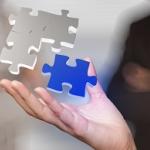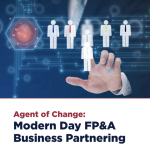The FP&A Business Partnering Maturity Model, developed by the International FP&A Board, evaluates an organisation's maturity in...

Financial Planning & Analysis (FP&A) transformation has become crucial for driving organisational performance and maintaining a competitive advantage in today's rapidly evolving business landscape. However, according to the 2022 FP&A Trends Survey, only a third of FP&A's time is spent on high-value activities such as generating insights and supporting decision-making. Still, 45% of the time is spent on data-related problems. These problems do not solely stem from technology but rather from the lack of a data-driven culture.
To achieve FP&A transformation, organisations must master the soft dimensions that underpin the process and culture. This article emphasises the significance of leadership, functional roles, and Business Partnering as catalysts for FP&A transformation. By balancing soft and hard dimensions, organisations can effectively drive FP&A transformation and unlock their full potential.
Let us delve into each of these three dimensions in more detail.

Figure 1
Effective Leadership for Data-Driven FP&A Transformation
Leadership is critical in establishing a data-driven culture enabling FP&A transformation. Influential FP&A leaders should set a clear vision for the organisation and inspire their teams to adopt new technologies and methodologies to enhance decision-making. The CFO's role in fostering a growth mindset that encourages innovation and adaptability is vital.
For example, Satya Nadella, Microsoft's CEO, exemplifies data-driven leadership and has transformed the company's culture to embrace data-driven decision-making fully. Nadella's approach, characterised by a clear vision, open communication, courage, humility, empathy, and the ability to energise teams, can inspire FP&A leaders to foster a similar data-driven culture. By adopting this approach, FP&A leaders can drive innovation, improve business performance, and unlock the full potential of FP&A transformation.
Functional Roles: The Building Blocks of FP&A Transformation
Effective Business Partnering and establishing a data-driven culture are vital for successful FP&A transformation. To achieve these objectives, FP&A professionals must excel in various functional roles. The five essential FP&A team roles include Analyst, Data Scientist, Architect, Storyteller, and Influencer.
1. The FP&A Data Scientist
It is a bridge between finance and data science, skilled in predictive technologies (AI/ML) and master data management. They uncover drivers and trends, integrate AI/ML/optimisation/statistical modelling techniques into FP&A processes, and analyse and present data.
2. The FP&A Architect
This person plays a vital role in harmonising analytical models, technology, and processes into an ecosystem that enables data-driven decision-making and supports FP&A transformation. They possess IT, analytics, and finance expertise and thoroughly understand the business.
3. The FP&A Analyst
These people are responsible for data analysis, financial modelling, and providing insights to support decision-making. They oversee budgeting and forecasting processes and evaluate potential investments and projects to enable effective financial planning and strategy development.
4. The FP&A Storyteller
This role delivers compelling insights and visualisations, making the story engaging and understandable for various stakeholders. They turn complex issues into simple insights and communicate the necessary actions to drive decision-making.
5. The FP&A Influencer
Finally, they are a key leader who uses their expertise in data and analytics to influence decision-making across the organisation, even without formal authority. They possess strong communication skills, emotional intelligence, and the ability to build internal and external networks to drive collaboration and alignment. The effective FP&A storytelling skills of the Storyteller and Influencer can help shift the organisation's mindset towards a data-driven culture, enabling more informed and strategic decision-making.
FP&A Business Partnering
FP&A Business Partners are highly skilled finance professionals who act as strategic advisors and change agents, using data analytics and storytelling to optimise business performance. They possess various skills, including analytical and modelling ones, industry-specific knowledge and other soft skills such as communication and relationship-building, and technological proficiency.
During the COVID-19 pandemic, Medtronic's FP&A function demonstrated the value of agile Business Partnering and data-driven decision-making. The company's FP&A Business Partners leveraged their skills and expertise to adjust to the rapidly changing business environment quickly.
By treating data as an asset and facilitating a data-driven culture, Medtronic's FP&A function quickly identified areas of risk and opportunity, allowing the company to remain responsive to changing market conditions and leading to improved business performance and success.
FP&A Business Partners can help transform processes and systems, educate and influence others, and optimise business performance through valuable insights from their deep financial and business expertise. Their skills and competencies are essential for effectively driving business decisions and optimising organisational performance in times of uncertainty.
Balancing Hard and Soft Dimensions for Successful FP&A Transformation
Balancing processes, data, analytics, and technology with soft dimensions such as leadership, communication, and relationship-building is crucial. Data is a key component in FP&A, similar to an atom in a living organism. We, as FP&A professionals, have to understand the organisation's needs and values to leverage technology and data effectively.
FP&A can help implement a data-driven culture by:
- identifying and communicating the business value of data,
- creating an information catalogue,
- addressing cultural change impacts,
- establishing measurable metrics,
- developing communication and influence plans,
- and managing ethical implications.
Successful implementation of these concepts has been seen in many organisations, such as Medtronic's FP&A function, which increased the speed of data-driven initiatives during the pandemic by mastering soft dimensions.
Transforming FP&A: The Essential Five "Soft" Steps

Figure 2
Below, I outline the five steps to help you embark on your transformational journey.
1. Leadership for Data-Driven Business Culture:
- Define a clear vision for the organisation's data-driven culture and communicate it effectively to all levels.
- Encourage innovation and adaptability by incentivising and rewarding team members who embrace new technologies and methodologies.
2. Build Functional Expertise:
- Hire professionals with the technical and soft skills to excel in essential FP&A roles.
- Provide ongoing training and development opportunities to ensure teams stay up-to-date with emerging technologies and best practices.
3. Develop Best in Class FP&A Business Partnering:
- Collaborate with key stakeholders to establish data-driven decision-making processes that optimise business performance.
- Foster cross-functional relationships by creating opportunities for FP&A professionals to work with other departments. Remember to gain a better understanding of their needs and objectives.
4. Establish Metrics and Communication Plans:
- Develop a comprehensive information catalogue that defines and catalogues data sources and how they are used.
- Establish measurable metrics and KPIs that align with organisational goals and objectives and use them to drive data-driven decision-making.
5. Manage Ethical Implications:
- Create an ethical framework that promotes the responsible use of data and establishes data privacy and security guidelines.
- Provide ongoing training to ensure all team members understand and adhere to the ethical principles of data management and decision-making.
Conclusions
In conclusion, mastering the soft dimensions of leadership, functional roles, and Business Partnering is crucial for FP&A transformation success. By fostering a data-driven culture, developing essential FP&A functional expertise, and fostering collaborative relationships with Business Partners, organisations can navigate the transformation process and propel their FP&A transformation journey.
Access the related content below to learn more and follow me on LinkedIn for more insights on the best practices in modern FP&A.
Subscribe to
FP&A Trends Digest

We will regularly update you on the latest trends and developments in FP&A. Take the opportunity to have articles written by finance thought leaders delivered directly to your inbox; watch compelling webinars; connect with like-minded professionals; and become a part of our global community.





